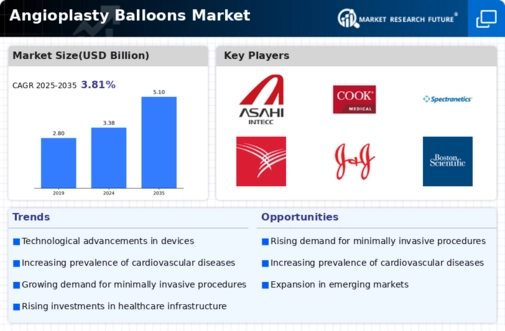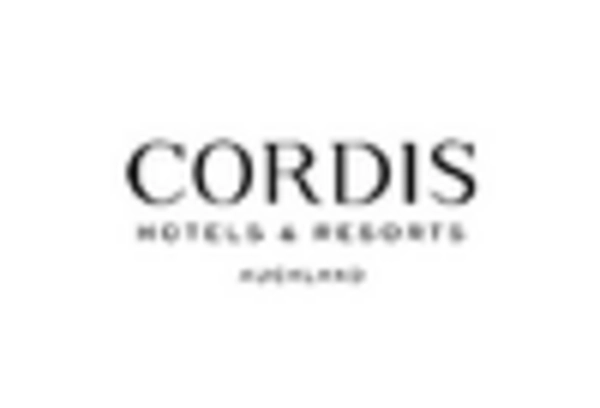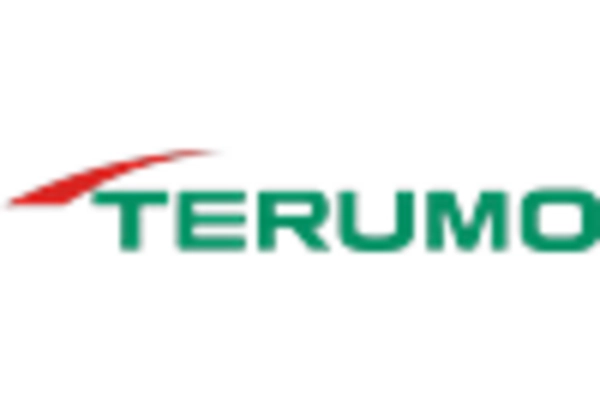Drug-Eluting Balloons
Plain Old Balloons
Scoring Balloons
Coronary Angioplasty
Peripheral Angioplasty
Renal Angioplasty
Polymer
Latex
Metal
Hospitals
Ambulatory Surgical Centers
Cardiac Catheterization Laboratories
North America
Europe
South America
Asia Pacific
Middle East and Africa
North America Outlook (USD Billion, 2019-2035)
North America Angioplasty Balloons Market by Type
Drug-Eluting Balloons
Plain Old Balloons
Scoring Balloons
North America Angioplasty Balloons Market by Application Type
Coronary Angioplasty
Peripheral Angioplasty
Renal Angioplasty
North America Angioplasty Balloons Market by Material Type
Polymer
Latex
Metal
North America Angioplasty Balloons Market by End Use Type
Hospitals
Ambulatory Surgical Centers
Cardiac Catheterization Laboratories
North America Angioplasty Balloons Market by Regional Type
US
Canada
US Outlook (USD Billion, 2019-2035)
US Angioplasty Balloons Market by Type
Drug-Eluting Balloons
Plain Old Balloons
Scoring Balloons
US Angioplasty Balloons Market by Application Type
Coronary Angioplasty
Peripheral Angioplasty
Renal Angioplasty
US Angioplasty Balloons Market by Material Type
Polymer
Latex
Metal
US Angioplasty Balloons Market by End Use Type
Hospitals
Ambulatory Surgical Centers
Cardiac Catheterization Laboratories
CANADA Outlook (USD Billion, 2019-2035)
CANADA Angioplasty Balloons Market by Type
Drug-Eluting Balloons
Plain Old Balloons
Scoring Balloons
CANADA Angioplasty Balloons Market by Application Type
Coronary Angioplasty
Peripheral Angioplasty
Renal Angioplasty
CANADA Angioplasty Balloons Market by Material Type
Polymer
Latex
Metal
CANADA Angioplasty Balloons Market by End Use Type
Hospitals
Ambulatory Surgical Centers
Cardiac Catheterization Laboratories
Europe Outlook (USD Billion, 2019-2035)
Europe Angioplasty Balloons Market by Type
Drug-Eluting Balloons
Plain Old Balloons
Scoring Balloons
Europe Angioplasty Balloons Market by Application Type
Coronary Angioplasty
Peripheral Angioplasty
Renal Angioplasty
Europe Angioplasty Balloons Market by Material Type
Polymer
Latex
Metal
Europe Angioplasty Balloons Market by End Use Type
Hospitals
Ambulatory Surgical Centers
Cardiac Catheterization Laboratories
Europe Angioplasty Balloons Market by Regional Type
Germany
UK
France
Russia
Italy
Spain
Rest of Europe
GERMANY Outlook (USD Billion, 2019-2035)
GERMANY Angioplasty Balloons Market by Type
Drug-Eluting Balloons
Plain Old Balloons
Scoring Balloons
GERMANY Angioplasty Balloons Market by Application Type
Coronary Angioplasty
Peripheral Angioplasty
Renal Angioplasty
GERMANY Angioplasty Balloons Market by Material Type
Polymer
Latex
Metal
GERMANY Angioplasty Balloons Market by End Use Type
Hospitals
Ambulatory Surgical Centers
Cardiac Catheterization Laboratories
UK Outlook (USD Billion, 2019-2035)
UK Angioplasty Balloons Market by Type
Drug-Eluting Balloons
Plain Old Balloons
Scoring Balloons
UK Angioplasty Balloons Market by Application Type
Coronary Angioplasty
Peripheral Angioplasty
Renal Angioplasty
UK Angioplasty Balloons Market by Material Type
Polymer
Latex
Metal
UK Angioplasty Balloons Market by End Use Type
Hospitals
Ambulatory Surgical Centers
Cardiac Catheterization Laboratories
FRANCE Outlook (USD Billion, 2019-2035)
FRANCE Angioplasty Balloons Market by Type
Drug-Eluting Balloons
Plain Old Balloons
Scoring Balloons
FRANCE Angioplasty Balloons Market by Application Type
Coronary Angioplasty
Peripheral Angioplasty
Renal Angioplasty
FRANCE Angioplasty Balloons Market by Material Type
Polymer
Latex
Metal
FRANCE Angioplasty Balloons Market by End Use Type
Hospitals
Ambulatory Surgical Centers
Cardiac Catheterization Laboratories
RUSSIA Outlook (USD Billion, 2019-2035)
RUSSIA Angioplasty Balloons Market by Type
Drug-Eluting Balloons
Plain Old Balloons
Scoring Balloons
RUSSIA Angioplasty Balloons Market by Application Type
Coronary Angioplasty
Peripheral Angioplasty
Renal Angioplasty
RUSSIA Angioplasty Balloons Market by Material Type
Polymer
Latex
Metal
RUSSIA Angioplasty Balloons Market by End Use Type
Hospitals
Ambulatory Surgical Centers
Cardiac Catheterization Laboratories
ITALY Outlook (USD Billion, 2019-2035)
ITALY Angioplasty Balloons Market by Type
Drug-Eluting Balloons
Plain Old Balloons
Scoring Balloons
ITALY Angioplasty Balloons Market by Application Type
Coronary Angioplasty
Peripheral Angioplasty
Renal Angioplasty
ITALY Angioplasty Balloons Market by Material Type
Polymer
Latex
Metal
ITALY Angioplasty Balloons Market by End Use Type
Hospitals
Ambulatory Surgical Centers
Cardiac Catheterization Laboratories
SPAIN Outlook (USD Billion, 2019-2035)
SPAIN Angioplasty Balloons Market by Type
Drug-Eluting Balloons
Plain Old Balloons
Scoring Balloons
SPAIN Angioplasty Balloons Market by Application Type
Coronary Angioplasty
Peripheral Angioplasty
Renal Angioplasty
SPAIN Angioplasty Balloons Market by Material Type
Polymer
Latex
Metal
SPAIN Angioplasty Balloons Market by End Use Type
Hospitals
Ambulatory Surgical Centers
Cardiac Catheterization Laboratories
REST OF EUROPE Outlook (USD Billion, 2019-2035)
REST OF EUROPE Angioplasty Balloons Market by Type
Drug-Eluting Balloons
Plain Old Balloons
Scoring Balloons
REST OF EUROPE Angioplasty Balloons Market by Application Type
Coronary Angioplasty
Peripheral Angioplasty
Renal Angioplasty
REST OF EUROPE Angioplasty Balloons Market by Material Type
Polymer
Latex
Metal
REST OF EUROPE Angioplasty Balloons Market by End Use Type
Hospitals
Ambulatory Surgical Centers
Cardiac Catheterization Laboratories
APAC Outlook (USD Billion, 2019-2035)
APAC Angioplasty Balloons Market by Type
Drug-Eluting Balloons
Plain Old Balloons
Scoring Balloons
APAC Angioplasty Balloons Market by Application Type
Coronary Angioplasty
Peripheral Angioplasty
Renal Angioplasty
APAC Angioplasty Balloons Market by Material Type
Polymer
Latex
Metal
APAC Angioplasty Balloons Market by End Use Type
Hospitals
Ambulatory Surgical Centers
Cardiac Catheterization Laboratories
APAC Angioplasty Balloons Market by Regional Type
China
India
Japan
South Korea
Malaysia
Thailand
Indonesia
Rest of APAC
CHINA Outlook (USD Billion, 2019-2035)
CHINA Angioplasty Balloons Market by Type
Drug-Eluting Balloons
Plain Old Balloons
Scoring Balloons
CHINA Angioplasty Balloons Market by Application Type
Coronary Angioplasty
Peripheral Angioplasty
Renal Angioplasty
CHINA Angioplasty Balloons Market by Material Type
Polymer
Latex
Metal
CHINA Angioplasty Balloons Market by End Use Type
Hospitals
Ambulatory Surgical Centers
Cardiac Catheterization Laboratories
INDIA Outlook (USD Billion, 2019-2035)
INDIA Angioplasty Balloons Market by Type
Drug-Eluting Balloons
Plain Old Balloons
Scoring Balloons
INDIA Angioplasty Balloons Market by Application Type
Coronary Angioplasty
Peripheral Angioplasty
Renal Angioplasty
INDIA Angioplasty Balloons Market by Material Type
Polymer
Latex
Metal
INDIA Angioplasty Balloons Market by End Use Type
Hospitals
Ambulatory Surgical Centers
Cardiac Catheterization Laboratories
JAPAN Outlook (USD Billion, 2019-2035)
JAPAN Angioplasty Balloons Market by Type
Drug-Eluting Balloons
Plain Old Balloons
Scoring Balloons
JAPAN Angioplasty Balloons Market by Application Type
Coronary Angioplasty
Peripheral Angioplasty
Renal Angioplasty
JAPAN Angioplasty Balloons Market by Material Type
Polymer
Latex
Metal
JAPAN Angioplasty Balloons Market by End Use Type
Hospitals
Ambulatory Surgical Centers
Cardiac Catheterization Laboratories
SOUTH KOREA Outlook (USD Billion, 2019-2035)
SOUTH KOREA Angioplasty Balloons Market by Type
Drug-Eluting Balloons
Plain Old Balloons
Scoring Balloons
SOUTH KOREA Angioplasty Balloons Market by Application Type
Coronary Angioplasty
Peripheral Angioplasty
Renal Angioplasty
SOUTH KOREA Angioplasty Balloons Market by Material Type
Polymer
Latex
Metal
SOUTH KOREA Angioplasty Balloons Market by End Use Type
Hospitals
Ambulatory Surgical Centers
Cardiac Catheterization Laboratories
MALAYSIA Outlook (USD Billion, 2019-2035)
MALAYSIA Angioplasty Balloons Market by Type
Drug-Eluting Balloons
Plain Old Balloons
Scoring Balloons
MALAYSIA Angioplasty Balloons Market by Application Type
Coronary Angioplasty
Peripheral Angioplasty
Renal Angioplasty
MALAYSIA Angioplasty Balloons Market by Material Type
Polymer
Latex
Metal
MALAYSIA Angioplasty Balloons Market by End Use Type
Hospitals
Ambulatory Surgical Centers
Cardiac Catheterization Laboratories
THAILAND Outlook (USD Billion, 2019-2035)
THAILAND Angioplasty Balloons Market by Type
Drug-Eluting Balloons
Plain Old Balloons
Scoring Balloons
THAILAND Angioplasty Balloons Market by Application Type
Coronary Angioplasty
Peripheral Angioplasty
Renal Angioplasty
THAILAND Angioplasty Balloons Market by Material Type
Polymer
Latex
Metal
THAILAND Angioplasty Balloons Market by End Use Type
Hospitals
Ambulatory Surgical Centers
Cardiac Catheterization Laboratories
INDONESIA Outlook (USD Billion, 2019-2035)
INDONESIA Angioplasty Balloons Market by Type
Drug-Eluting Balloons
Plain Old Balloons
Scoring Balloons
INDONESIA Angioplasty Balloons Market by Application Type
Coronary Angioplasty
Peripheral Angioplasty
Renal Angioplasty
INDONESIA Angioplasty Balloons Market by Material Type
Polymer
Latex
Metal
INDONESIA Angioplasty Balloons Market by End Use Type
Hospitals
Ambulatory Surgical Centers
Cardiac Catheterization Laboratories
REST OF APAC Outlook (USD Billion, 2019-2035)
REST OF APAC Angioplasty Balloons Market by Type
Drug-Eluting Balloons
Plain Old Balloons
Scoring Balloons
REST OF APAC Angioplasty Balloons Market by Application Type
Coronary Angioplasty
Peripheral Angioplasty
Renal Angioplasty
REST OF APAC Angioplasty Balloons Market by Material Type
Polymer
Latex
Metal
REST OF APAC Angioplasty Balloons Market by End Use Type
Hospitals
Ambulatory Surgical Centers
Cardiac Catheterization Laboratories
South America Outlook (USD Billion, 2019-2035)
South America Angioplasty Balloons Market by Type
Drug-Eluting Balloons
Plain Old Balloons
Scoring Balloons
South America Angioplasty Balloons Market by Application Type
Coronary Angioplasty
Peripheral Angioplasty
Renal Angioplasty
South America Angioplasty Balloons Market by Material Type
Polymer
Latex
Metal
South America Angioplasty Balloons Market by End Use Type
Hospitals
Ambulatory Surgical Centers
Cardiac Catheterization Laboratories
South America Angioplasty Balloons Market by Regional Type
Brazil
Mexico
Argentina
Rest of South America
BRAZIL Outlook (USD Billion, 2019-2035)
BRAZIL Angioplasty Balloons Market by Type
Drug-Eluting Balloons
Plain Old Balloons
Scoring Balloons
BRAZIL Angioplasty Balloons Market by Application Type
Coronary Angioplasty
Peripheral Angioplasty
Renal Angioplasty
BRAZIL Angioplasty Balloons Market by Material Type
Polymer
Latex
Metal
BRAZIL Angioplasty Balloons Market by End Use Type
Hospitals
Ambulatory Surgical Centers
Cardiac Catheterization Laboratories
MEXICO Outlook (USD Billion, 2019-2035)
MEXICO Angioplasty Balloons Market by Type
Drug-Eluting Balloons
Plain Old Balloons
Scoring Balloons
MEXICO Angioplasty Balloons Market by Application Type
Coronary Angioplasty
Peripheral Angioplasty
Renal Angioplasty
MEXICO Angioplasty Balloons Market by Material Type
Polymer
Latex
Metal
MEXICO Angioplasty Balloons Market by End Use Type
Hospitals
Ambulatory Surgical Centers
Cardiac Catheterization Laboratories
ARGENTINA Outlook (USD Billion, 2019-2035)
ARGENTINA Angioplasty Balloons Market by Type
Drug-Eluting Balloons
Plain Old Balloons
Scoring Balloons
ARGENTINA Angioplasty Balloons Market by Application Type
Coronary Angioplasty
Peripheral Angioplasty
Renal Angioplasty
ARGENTINA Angioplasty Balloons Market by Material Type
Polymer
Latex
Metal
ARGENTINA Angioplasty Balloons Market by End Use Type
Hospitals
Ambulatory Surgical Centers
Cardiac Catheterization Laboratories
REST OF SOUTH AMERICA Outlook (USD Billion, 2019-2035)
REST OF SOUTH AMERICA Angioplasty Balloons Market by Type
Drug-Eluting Balloons
Plain Old Balloons
Scoring Balloons
REST OF SOUTH AMERICA Angioplasty Balloons Market by Application Type
Coronary Angioplasty
Peripheral Angioplasty
Renal Angioplasty
REST OF SOUTH AMERICA Angioplasty Balloons Market by Material Type
Polymer
Latex
Metal
REST OF SOUTH AMERICA Angioplasty Balloons Market by End Use Type
Hospitals
Ambulatory Surgical Centers
Cardiac Catheterization Laboratories
MEA Outlook (USD Billion, 2019-2035)
MEA Angioplasty Balloons Market by Type
Drug-Eluting Balloons
Plain Old Balloons
Scoring Balloons
MEA Angioplasty Balloons Market by Application Type
Coronary Angioplasty
Peripheral Angioplasty
Renal Angioplasty
MEA Angioplasty Balloons Market by Material Type
Polymer
Latex
Metal
MEA Angioplasty Balloons Market by End Use Type
Hospitals
Ambulatory Surgical Centers
Cardiac Catheterization Laboratories
MEA Angioplasty Balloons Market by Regional Type
GCC Countries
South Africa
Rest of MEA
GCC COUNTRIES Outlook (USD Billion, 2019-2035)
GCC COUNTRIES Angioplasty Balloons Market by Type
Drug-Eluting Balloons
Plain Old Balloons
Scoring Balloons
GCC COUNTRIES Angioplasty Balloons Market by Application Type
Coronary Angioplasty
Peripheral Angioplasty
Renal Angioplasty
GCC COUNTRIES Angioplasty Balloons Market by Material Type
Polymer
Latex
Metal
GCC COUNTRIES Angioplasty Balloons Market by End Use Type
Hospitals
Ambulatory Surgical Centers
Cardiac Catheterization Laboratories
SOUTH AFRICA Outlook (USD Billion, 2019-2035)
SOUTH AFRICA Angioplasty Balloons Market by Type
Drug-Eluting Balloons
Plain Old Balloons
Scoring Balloons
SOUTH AFRICA Angioplasty Balloons Market by Application Type
Coronary Angioplasty
Peripheral Angioplasty
Renal Angioplasty
SOUTH AFRICA Angioplasty Balloons Market by Material Type
Polymer
Latex
Metal
SOUTH AFRICA Angioplasty Balloons Market by End Use Type
Hospitals
Ambulatory Surgical Centers
Cardiac Catheterization Laboratories
REST OF MEA Outlook (USD Billion, 2019-2035)
REST OF MEA Angioplasty Balloons Market by Type
Drug-Eluting Balloons
Plain Old Balloons
Scoring Balloons
REST OF MEA Angioplasty Balloons Market by Application Type
Coronary Angioplasty
Peripheral Angioplasty
Renal Angioplasty
REST OF MEA Angioplasty Balloons Market by Material Type
Polymer
Latex
Metal
REST OF MEA Angioplasty Balloons Market by End Use Type
Hospitals
Ambulatory Surgical Centers
Cardiac Catheterization Laboratories

















Leave a Comment